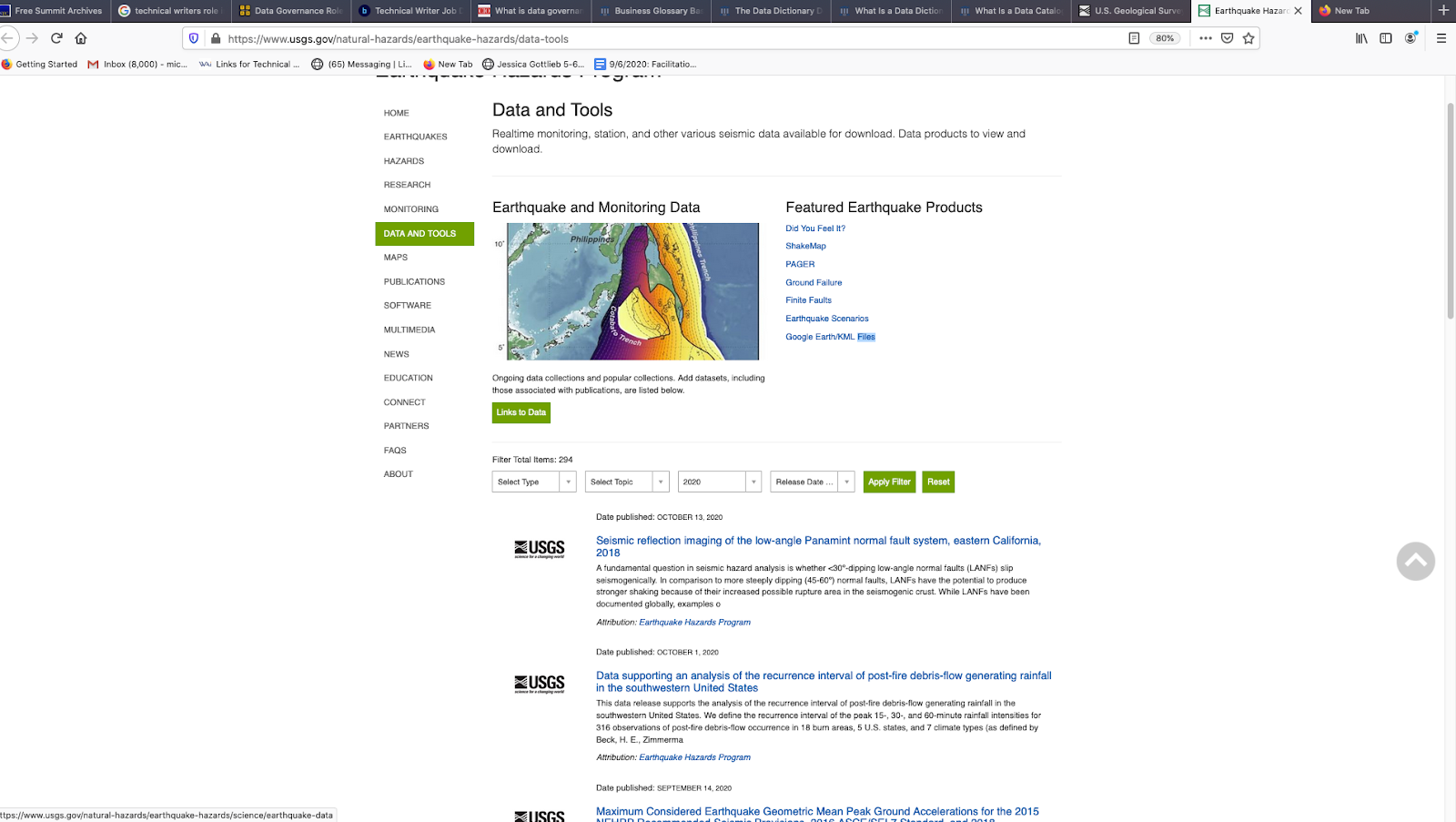
What technical writers need to know about data governance – by Michelle Knight
By Michelle Knight on Writing docs from December 30, 2020
 Image Courtesy of Donna Burbank and Global Data Strategy
Image Courtesy of Donna Burbank and Global Data Strategy
Technical writers, if not already significant players in guiding data governance, will be. Data governance defines who (within a company) can use and manage data. Company stakeholders and users rely on easily digestible and understandable documentation about formal practices and processes on how to manage information. Unfortunately, many writers struggle to meet quality and time demands from situations like those depicted in the cartoon above. Imagine sitting in a meeting before the final release where subject matter experts (SMEs) debate the business meaning of “customer,” an essential and frequently mentioned term. You would be tearing your hair, figuring what specs or user guides would need to be changed and how you could do those edits at light speed.
To counter confusion and have better project successes, more companies invest or plan to invest in data governance. In a recent white paper I wrote for DATAVERSITY®, 2020 Trends in Data Management, most of the 294 participants surveyed stated that they have built or will build a data governance initiative. About 60 percent of all respondents said they already had some data governance in an initial phase. As organizations start-up and improve data governance, those technical writers who know what it is and how to leverage it and its document deliverables will have an advantage.
What is data governance?
Data governance describes the collaboration among people and technology to ensure a business’ information can be used efficiently and legally for business activities and remain understandable and trustworthy.
Examples of data governance programs abound. Several use cases from a talk given by Nigel Turner and Donna Burbank depict data governance goals and steps taken. While specific data governance reasons and outcomes differ, in addition to company cultures and business models, common themes emerge.
Typically, you see new data governance programs geared towards improving data quality, making the information fit for purpose. Representatives from different departments get involved. Senior managers advocate or form some committees or working groups that include different departmental representatives. As a result, people across the organization collaborate and agree to deliverables, including data governance documentation and initiative evaluations. Governance representatives revisit and retool data governance activities throughout a business’ lifetime.
Given this situation, I see that data governance informs and guides the technical writer to create, modify, and archive documentation and opens-up new opportunities to expand his or her role.
Why should technical writers care about data governance?
When thinking about why technical writers should care about data governance, consider what happens without it. Let me explain. I worked in quality assurance seven years ago with a technical writer on a project creating a health insurance survey tool — Let us call the technical writer Chris. Chris needed to do some research to write the user manual, and no data governance existed.
Chris set out to find not only how the program worked, but who owned the health insurance data, what it meant, and who took responsibility for it. Chris sat down with the project’s developers and IT business representatives. She asked questions, took notes, and clarified content for her user’s guide.
Throughout this process, Chris ended up cobbling some data governance to figure out how to instruct users on taking the health survey. This task was made even harder by discord between how different departments defined data and user content. I remember she and the other developers on the project had a heated exchange or two with another internal department.
Furthermore, without data governance authority, Chris’s content became subject to last-minute changes and rewrites. Previously decided requirements needed to be altered based on new information and a lack of clarity on who managed the organization’s data and how. As a result, using her documentation became problematic.
If data governance had existed within the entire health insurance company and applied to its projects, Chris could have wasted less time trying to access and understand requirements. She could use existing governance materials, like a business glossary, to write her user guide. With the authority and checks provided by data governance deliverables, Chris would have what she needed to create a document speedily and with good quality without spending so much time figuring out what to write.
Today, data must exist for a technical writer. Data volumes and variety continue to increase and expand rapidly. Too many loose ends exist for one technical writer to do thorough research. Moreover, high profile data breaches and new data protection laws like the GDPR and CCPA raise higher scrutiny of any released software and accompanying documentation to ensure privacy and compliance. Simply put, any technical writer has to care about data governance to keep the workload manageable, write high-quality documentation, and comply with local regulations on protecting their user’s information.
Will data governance change how technical writers work?
Data governance initiatives will radically change how a technical writer creates, updates, modifies, deletes, and archives content. In addition to making it easier to access and understand requirements, data governance will guide technical writers to:
Standardize written content’s accessibility and security: An organization’s user manuals, standard operating procedures (SOP), and other documentation make up valuable company information that can be leveraged and reused. Data governance keeps the integrity of written materials while making them easier to find and repurpose.
Research data context: Data governance offers the potential for good metadata management. Metadata describes data, giving technical, business, and operational context. While governance will manage what metadata technical writers must include in their documentation, these authors will benefit by more easily finding out related data assets and owners, saving time writing content in the future.
Maintain and update written content reasonably: Data governance roles like a data steward take responsibility to keep technical and business contents useful, including setting and managing guidelines around data. Also, data stewards can take up some content maintenance, freeing the technical writer to do more engaging and desirable writing tasks.
Become more valuable: Why not see if a glossary or another type of data governance documentation deliverable could reuse some of the content produced in a technical user guide or FAQ page. Technical writers can augment their role as someone that streamlines data documentation. Then advocate for higher pay.
The nuts and bolts of how technical writing integrates with data governance will vary with different employers and cultures. For example, the UNSW (University of North-South Wales) Sydney, Australia, has a very hierarchical data governance structure where university leaders drive data and information control and access. While Freddie Mac, a mortgage financier, has different types and levels of control depending on the data and information. An executive committee oversees different priorities at the end of the day. Technical writers need to request some training about a company’s data governance, even if it is just a spreadsheet of names, initiatives, and activities, to know how data governance works in their organization.
What are some useful data governance tools for technical writers?
Taking advantage of good data governance tools will save a technical writer time. Look out for some of these common data governance resources:
Business glossaries: Business glossaries, as mentioned above, describe shared terms and meanings across an organization. As a technical writer, you will want to check your document terminology aligns with the latest business glossary meanings.
Data dictionaries: Data dictionaries talk about how to use database systems for business reports and purposes. Dictionary contents describe database elements and relationships. Technical writers who understand data dictionaries get the reasoning behind the program.
Data catalogs: Data catalogs provide context about different data sets, like who put them together, when they have last been updated, and why the organization collected the data sets. See an example below of a data catalog.
 Image Courtesy of the USGS Earthquake Hazards Program
Image Courtesy of the USGS Earthquake Hazards ProgramData governance platforms: Data governance platforms provide a centralized technological solution where team members can talk about policies and procedures and where algorithms enforce data quality. Some platforms also have data glossaries, data dictionaries, and data catalogs integrated, like Collibra’s or SAP’s data governance solutions. With any data governance platform, ask how it is used and by whom.
Data models: Data models describe software services and system design through diagrams, symbols, and text. Models can be physical (about the database tables, columns, any messages), logical (about the characteristics, rules, and relationships among data), or conceptual (about the business purpose and relationships it has to data). Data architects or modelers visualize and explain a software’s data model.
Conclusion
Many companies are starting to develop, if they have not already, data governance frameworks this year and the years to come. With this change comes a shift in focus for a document's contents. A tech writer could work with a few developers and SMEs to get good project documentation in the past. Today, companies have an enterprise or larger data governance about how any content fits all the business pieces. Technical writers must take the time to figure out how a company governs data; it determines data or content authority, and what documentation already exists to research. You will find this knowledge critical to creating relevant documentation that is trustworthy.
Additional data governance resources:
For more information, check out these additional resources:
DATAVERSITY — A data management educational resource with courses and articles.
DAMA International — A professional organization for data management education, certification, and career advancement.
The Data Governance Institute (DGI) — An organization that “provides in-depth, vendor-neutral Data Governance best practices and guidance.
KIK Consulting — consultants for non-invasive data governance that takes advantage of an organization’s existing data structure.
Data Governance Professionals Organization (DGPO) — An organization that connects all those in data governance, acting as a resource.


Writing docs
(253)

General posts useful to all documentarians about writing documentation, editing and publishing workflows, and more.


Feature spotlight
(15)

Your flight plan for how to get the most out of KnowledgeOwl features and integrate them into your workflows.


Announcements
(21)

Major KnowledgeOwl company announcements.


Customer stories
(9)

Learn how others are using KnowledgeOwl & get pro tips on how to make the most of KO!


Company culture
(40)

Find out more about who we are and what we value.


Support
(75)

We believe good support is the foundation of good business. Learn about support tools and methodology.


Tools
(64)

Learn more about tools to solve various documentarian issues, within and beyond KnowledgeOwl.


All
(384)

Not sure what category you need? Browse all the posts on our blog.

Got an idea for a post you'd like to read...or write?
We're always looking for guest bloggers.
Learn moreStart building your knowledge base today
- 30 days free (and easy to extend!)
- No credit card required
- Affordable, transparent pricing
- No cost for readers, only authors
Want to see it in action?
Watch a 5-minute video and schedule time to speak with one of our owls.



